A novella for entrée, an encyclopaedia for main course, and a digest for dessert: the literary tastes of the larval bookworm
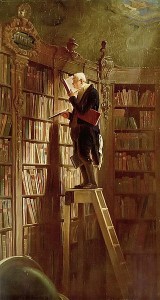 For many of us, the term ‘bookworm’ conjures up two popular creatures which inhabit the dimly lit recesses of libraries. One the pale voracious bibliophile, with an almost unhealthy all-consuming interest in books, much like the short-sighted reader depicted in the German artist and poet Carl Spitzweg’s painting The Bookworm (1850). The other more destructive, a bespectacled and well fed grub, who smiles with great satisfaction from a hole that it has bored through the pages of a book. Whilst we have probably met, or may even be a proud example of the former, how many of us have ever encountered one of the latter?
For many of us, the term ‘bookworm’ conjures up two popular creatures which inhabit the dimly lit recesses of libraries. One the pale voracious bibliophile, with an almost unhealthy all-consuming interest in books, much like the short-sighted reader depicted in the German artist and poet Carl Spitzweg’s painting The Bookworm (1850). The other more destructive, a bespectacled and well fed grub, who smiles with great satisfaction from a hole that it has bored through the pages of a book. Whilst we have probably met, or may even be a proud example of the former, how many of us have ever encountered one of the latter?
Indeed the larval bookworm is an elusive creature, whose presence is more often evidenced by the trail of damaging lacework it leaves behind. In this sense the bookworm’s crime is a perfect one in that it absconds after its eating spree had finished, metamorphosing into an adult insect, with its dastardly legacy only discovered many years after the attack. An example of the destructive peregrinations of a family of bookworms in a 17th century Persian manuscript in the Baillieu Library’s Rare Books Collection can be seen in this image.
The term bookworm is a generic one, and may refer to the larvae of several species of insect – including house moths, carpet beetles and the paper louse – which feed on paper, pastes, wood, cloth and moulds found in books. The grub’s fondness for cool, dark, humid and undisturbed corners of neglected bookshelves provides the perfect food source, and a home in which communities can thrive so secretly.
Due to the developments in paper making over time, the taste preferences of bookworms have meant that books produced between the mid-1450s to the 1820s are the most susceptible to this type of insect attack, when the ingredients used in paper making (cotton, linen, starch) were the most natural and pure. The larvae are not fond of animal parchment (which has protected very early books and medieval manuscripts), and the high proportion of chemicals and other additives in 19th and 20th century papers made them unattractive for the young grubs to eat.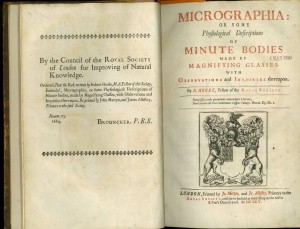
Despite their diminutive size, bookworms have captured the imagination of scientists, politicians, book lovers, poets, and even 20th century cartoonists. The earliest formal depiction of a ‘bookworm’ in Robert Hooke’s spectacularly hand-illustrated work Micrographia actually shows what we now know as a silverfish. Micrographia caused a sensation when it was published by the newly formed Royal Society in 1665, as it contained the first descriptions of the natural world as observed through a microscope. Never before had the eye of a fly, or the structure of a snowflake, or the intricate appearance of a ‘bookworm’, been seen in such magnified detail. 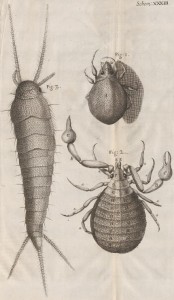
Hooke writes:
It is a small white silver-shining worm or moth, which I found much conversant among books and papers, and is suppos’d to be that which corrodes and eats holes through the leaves and covers…Its head appears bigg and blunt, and its body tapers from it towards the tail, smaller and smaller, being shap’d like a carret.
As well as attracting scientific interest, the bookworm has also inspired poetry, mostly in the form of humorous verse. John Dovaston (1782-1854) an English writer and naturalist, and close friend of the celebrated natural historian and wood engraver, Thomas Bewick (1753-1828), published his poem ‘Bookworms’ (playfully subtitled ‘How to Kill’) his 1825 anthology.
In the later 19th century, the bibliophile, William Blades in his The Enemies of Books (1880) devotes an entire chapter to the bookworm. Also adopting a humorous tone, he details the attack of the ‘worm’ (in this case a regiment) on an early work from the famous printing house of Peter Schoeffer of Mentz:
‘It is just as if there had been a race. In the first ten leaves the weak worms are left behind; in the second ten there are still 48 eaters; these are reduced to 31 in the third ten, and to only 18 in the fourth ten…Before reaching folio 71 it is a neck and neck race between two sturdy gourmands, each making a fine large hole, one of them being oval in shape…At folio 87, the oval worm gives in, the round one eating three more leaves and part way through the fourth’.
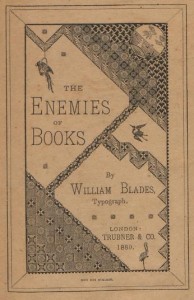
In 1879 a Northampton bookbinder sent Blades a live specimen of a ‘fat little worm’ which had been found in an old book by one of his assistants:
He bore his journey extremely well, being very lively when turned out. I placed him in a box in warmth and quiet, with some small fragments of paper from a Boethius, printed by Caxton, and a leaf of a seventeenth century book. He ate a small piece of the leaf, but either from too much fresh air, from unaccustomed liberty, or from change of food, he gradually weakened and died in about three weeks.
Despite their extensive destruction, these elusive creatures also found popular expression in the 20th century. Hugh Harman’s and Friz Freleng’s Metro-Goldwyn Mayer cartoon The Bookworm (1939) brought together a range of literary and historical characters – Macbeth’s witches, Robin Hood, Black Beauty – in the unsuccessful quest to catch an endearing worm who lives in a tunnel in a thick tome. Once again the worm triumphs https://www.youtube.com/watch?v=c3Hn6GQLyTs . And taking on an enemy guise, the villainous character ‘The Bookworm’ was played by Roddy McDowall in the 1960s television series Batman.
It seems certain that whilst both loathed and loved through history, the bookworm and its havoc will continue to intrigue scientists, surprise, frustrate and disappoint book lovers, and remain a delightfully enigmatic creature in the popular imagination.
Susan Thomas, Rare Books Curator
![Lavāʼiḥ [manuscript] [by] Nūr-al-Dīn ʻAbd al-Raḥmān Jāmī](https://blogs.unimelb.edu.au/librarycollections/files/2016/06/MUL-77-page-22-11mg1j7-300x231.png)
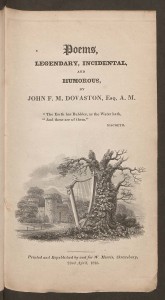
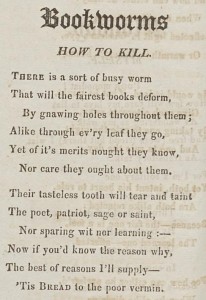
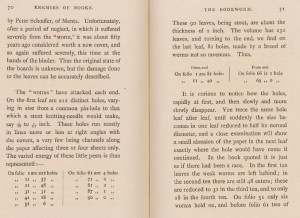
Leave a Reply